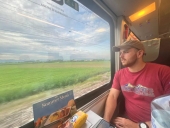 Source: Amazon.com
Source: Amazon.com
Author - Kaci Rae Christopher
Publisher - New Society Publishing
Summary
New Society Publishing says "The world needs young people to grow into strong, scientifically literate environmental stewards. Learning gardens are great places to build this knowledge, yet until now there has been a lack of a multi-grade curriculum for school-wide teaching aimed at fostering a connection with the Earth.
The School Garden Curriculum offers a unique and comprehensive framework, enabling students to grow their knowledge throughout the school year and build on it from kindergarten to eighth grade. From seasonal garden activities to inquiry projects and science-skill building, children will develop organic gardening solutions, a positive land ethic, systems thinking, and instincts for ecological stewardship."
About the Author
New Society Publishing says "Kaci Rae Christopher is the volunteer Farm and Garden Educator for Oregon's Redband Ranch. She was previously the School Garden Coordinator for the Springwater Environmental Sciences School, the Outdoor Educator for ERA, and worked on education farms, community supported agriculture initiatives, and farm schools. Her passion is fostering a healthy land ethic, personal empowerment, and environmental literacy in children of all ages through outdoor immersion and skill building in order to inspire generations of changemakers. Currently pursuing her MFA at OSU-Cascades, on most days Kaci Rae can be up to her elbows in soil or hiking new trails with her husband and two dogs. She lives in Bend, Oregon."
Where to get it?
New Society Publishing
amazon us
amazon uk
amazon ca
amazon au
Related Videos
playlist
Related Category and Forums
Education Category
Teachers' Lounge
Kids
Science and Research
PEP/PEX
Related Threads
How to Inspire Empathy and a Land Ethic that Lasts?
The Start of Our School Garden
Elementary School Garden
Leslie Bern's School Garden in Jordan
Permaculture For My Students, How Can I Teach Them?
Permaculture Curriculum Middle Schools
Support Food Justice Curriculum Nationwide
Permaculture For Ages 0-3
Related Websites
The School Garden Curriculum website
Collective School Garden Network
Whole Kids School Gardens

 1
1





 1
1


















 1
1




 2
2




 ), nor can we learn to grow food overnight. We have to teach our young ones how to grow their own food, ideally within community. Kaci Rae's book, if we promote it and get it into schools and school systems, could be one of the most important books ever for our children's health, well-being ... and survival.
), nor can we learn to grow food overnight. We have to teach our young ones how to grow their own food, ideally within community. Kaci Rae's book, if we promote it and get it into schools and school systems, could be one of the most important books ever for our children's health, well-being ... and survival.
 2
2




 3
3














